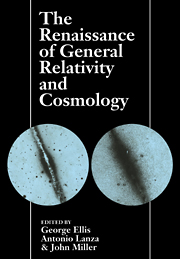 The Renaissance of General Relativity and Cosmology
The Renaissance of General Relativity and Cosmology Book contents
- Frontmatter
- Contents
- Author Addresses
- 1 Introduction
- 2 Exact and inexact solutions of the Einstein field equations
- 3 Inertial forces in general relativity
- 4 Relativistic radiation hydrodynamics: a covariant theory of flux-limiters
- 5 Relativistic gravitational collapse
- 6 The cosmic censorship hypothesis
- 7 The Kerr metric: a gateway to the roots of gravity?
- 8 Galactic astronomy since 1950
- 9 Galaxy distribution functions
- 10 Nonlinear galaxy clustering
- 11 Quasars: progress and prospects
- 12 Decaying neutrinos in astronomy and cosmology
- 13 Cosmological principles
- 14 Anisotropic and inhomogeneous cosmologies
- 15 Mach's principle and isotropic singularities
- 16 Implications of superconductivity in cosmic string theory
- 17 The formation and evaporation of primordial black holes
- 18 Evaporation of two dimensional black holes
- 19 Topology and topology change in general relativity
- 20 Decoherence of the cluttered quantum vacuum
- 21 Quantum non-locality and complex reality
- 22 The different levels of connections between science and objective reality
9 - Galaxy distribution functions
Published online by Cambridge University Press: 15 December 2009
- Frontmatter
- Contents
- Author Addresses
- 1 Introduction
- 2 Exact and inexact solutions of the Einstein field equations
- 3 Inertial forces in general relativity
- 4 Relativistic radiation hydrodynamics: a covariant theory of flux-limiters
- 5 Relativistic gravitational collapse
- 6 The cosmic censorship hypothesis
- 7 The Kerr metric: a gateway to the roots of gravity?
- 8 Galactic astronomy since 1950
- 9 Galaxy distribution functions
- 10 Nonlinear galaxy clustering
- 11 Quasars: progress and prospects
- 12 Decaying neutrinos in astronomy and cosmology
- 13 Cosmological principles
- 14 Anisotropic and inhomogeneous cosmologies
- 15 Mach's principle and isotropic singularities
- 16 Implications of superconductivity in cosmic string theory
- 17 The formation and evaporation of primordial black holes
- 18 Evaporation of two dimensional black holes
- 19 Topology and topology change in general relativity
- 20 Decoherence of the cluttered quantum vacuum
- 21 Quantum non-locality and complex reality
- 22 The different levels of connections between science and objective reality
Summary
This is mainly a review of the properties of gravitational galaxy distribution functions. It discusses their theoretical derivation, comparison with N-body simulations, and — perhaps most importantly — their observed features. The observed distribution functions place strong constraints on any theory of galaxy clustering.
INTRODUCTION
The galaxy distribution function f(N, v) is the probability of finding N galaxies in a given size volume of space (or in a projected area of the sky) with velocities between v and v + dv. It is the direct analog of the distribution function in the kinetic theory of gases. For perfect gases, the spatial distribution is provided by a Poisson distribution at low densities and a Gaussian distribution at high densities, along with a Maxwell-Boltzmann distribution for the velocities. It is only in the last few years that we have discovered the comparable distribution for galaxies interacting gravitationally in the expanding universe. There are still many aspects of this problem which need to be understood.
Distribution functions had their origin in the observations and speculations of William Herschel two hundred years ago. In his catalog of nebulae he noticed that their distribution was irregular over the sky. Although we now know that some of these nebulae were galaxies and others resulted from stars, HII regions and planetary nebulae, and that some of the irregularities are intrinsic while others are due to local obscuration by the interstellar matter in our Milky Way, Herschel tended to view them all as a single class of objects.
Information
- Type
- Chapter
- Information
- The Renaissance of General Relativity and CosmologyA Survey to Celebrate the 65th Birthday of Dennis Sciama, pp. 130 - 158Publisher: Cambridge University PressPrint publication year: 1993